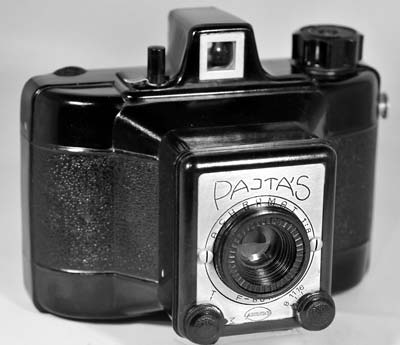Gamma Pajtás
Specification

| Manufacturer | : | Gamma |
|---|---|---|
| Produced | : | 1955 |
| Classification | : | Medium Format |
| Body Type | : | Solid Body |
| Construction | : | Bakelite |
| Film Type | : | 120 |
| Film Width | : | 62mm |
| Image Size | : | 6 x 6 cm |
| No. of Images | : | 12 |
| Lens Type | : | Achromat |
| Focal Length | : | 80mm |
| Focus Type | : | fixed |
| Focal Range | : | 8ft - Inf. |
| Aperture Type | : | Fixed |
| Apertures | : | f/8, f/11, f/16 |
| Shutter Type | : | Fixed Speed |
| Shutter Speeds | : | I*(1/30s) |
| Size (w x h x d) | : | 125 x 98 x 90 mm |
| Weight | : | 325g |
| * Measured on this camera | ||
Art Deco Credentials
![]()
![]()
Acceptable: Modest and restricted
- Produced after the main Art Deco period.
- Bakelite body with linear and embossed detailing.
- Leather patterning embossed in Bakelite
- Curvilinear body design.
- Art Deco font on face.
Description
The Pajtás (meaning "Companion" in Hungarian) is a Bakelite box camera made in Hungary by Gamma Optikai Müvek between 1955 and 1960. From 1960 it was made by Fövárosi Finommechanikai Vállalat (FFV). It is a simple camera with an integrated direct eye-level viewfinder.
Exposure settings can be instantaneous 1/30 (M) or B (T). It has three apertures (f8, f11, f16). The shutter function and apertures are selected via knobs below the 80mm f/8 achromat lens made by Magyar Optikail Müvek (MOM). It produces 12 images on 120 film.
The shutter release has a two position switch. In one position the shutter operates normally. In the other position the shutter is held open in 'T' mode until manually released. It has a tripod socket on the base.
How to Use
Don't forget to cover the red window except when winding on in subdued light.
This camera takes 120 film which is easily available. With a shutter speed of only 1/30 sec, make sure you brace the camera against your head or something solid and press the shutter smoothly to avoid camera shake.
If you don't want to bother with an exposure meter, follow the guide shown. It is based on the 'Sunny 16' rule. Film is so forgiving and will produce acceptable results even when over-exposed by 2 or 3 stops or under-exposed by 1 stop.
The table assumes that the sun is at least 30 degrees above the horizon - that's 10am - 5pm on a summers day in the UK.
Remember that the exposure guide in the manual may not be helpful as it is based on the use of old film with a low ISO value.
So, on a nice sunny day, it's simplicity itself. Just load film and snap away.
Using ISO 100/125 film - shutter speed 1/30s
| Weather Conditions | Shadow Detail | Aperture | Exposure |
|---|---|---|---|
 Sunny SunnySnow/Sand | Dark with sharp edges | f/16 | +3 Stop Overexposed Acceptable |
 Sunny Sunny | Distinct | f/16 | +2 Stops Overexposed Acceptable |
 Slight Overcast Slight Overcast | Soft around edges | f/16 | +1 Stop Overexposed Acceptable |
 Overcast Overcast | Barely visible | f/16 | Good |
 Heavy Overcast Heavy Overcast | None | f/11 | Good |
 Open Shade Open Shade/Sunset | None | f/8 | Good |